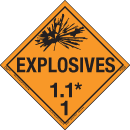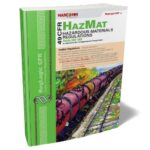Transport Canada Updates Explosive Packaging Standard
Under Canada’s “Transportation of Dangerous Goods Regulations” (TDGR), the first step in packaging is always finding the right standard to use. This varies by class, with general standards for most liquid or solid products, and special standards for gases, radioactives, infectious substances and explosives. Of course, as international standards evolve over time, Transport Canada must periodically update these standards, and has recently updated the standard for Class 1 Explosives.
Who Are the CGSB?
TDGR section 5.8 states that “A person must not offer for transport, handle or transport dangerous goods included in Class 1, unless they are in a means of containment that is selected and used in accordance with CGSB-43.151.” But where do we find this standard if it’s not actually in the regulations? It turns out not to be a difficult question, but it does take a few steps.
CGSB stands for the “Canadian General Standards Board,” described as “a federal government organization that offers client-centered, comprehensive standards development and conformity assessment services in support of the economic, regulatory, procurement, health, safety and environmental interests.” They are involved in standards development, management system programs and creating certification programs for many products and services. Many packaging standards are created and published by the CGSB.
Once, to obtain these dangerous goods packaging standards, you had to purchase hard copies. However, most of them are now available for free download as PDFs if you don’t want a hard copy. The Explosives standard can be downloaded from this page: https://publications.gc.ca/site/eng/9.936756/publication.html . Note that currently you may have to save the link and download it rather than clicking directly.
What’s New with CGSB-43.151
The latest edition of CAN/CGSB-43.151, “Packaging, handling, offering for transport and transport of explosives (Class 1)” was published April 18, 2024, replacing the previous edition from 2019. There is a six-month transition period for compliance.
Some of the notable changes are:
- The list of explosives, special provisions and packing instructions have been aligned with the 22nd edition of the UN Recommendations on the Transport of Dangerous Goods, Model Regulations. Of course, there is now the 23rd edition available but at least this will be more current than the previous standard.
- The standard incorporates updated references to other dangerous goods packaging standards. This includes the not-yet-published CGSB-43.150, which will replace Transport Canada Standard TP14850 for the typical liquid and solid dangerous goods.
- The packing instructions EP101, CEP 01 and CEP 02 have been updated to the 22nd edition of the UN Recommendations.
- New requirements have been added on the reuse of packagings and use of partially filled packagings to transport Class 1 Explosives.
- The decontamination requirements for packagings previous used for explosives have been updated.
- A provision has been added to prohibit the use of lightweight Intermediate Bulk Containers (IBCs) for the transport of Class 1 Explosives. Although these have become attractive options because of their low cost, studies of accidents involving them have determined that they are unsafe for explosives.
What Do You Need to Do?
If you don’t ship or design packages for explosives, the answer of course is “nothing.” However, if you’re involved in the transport of explosives, you should immediately download the CGSB standard and see if it will affect your packaging or procedures. Remember you have until October 18th 2024 to be in full compliance with the changes.
Questions about packaging or identifying explosives for transport? Our team of experts is just a call away for our customers at 855.734.5469 or send us an email, we’re happy to help.
Stay up to date and sign up for our newsletter!
We have all the products, services and training you need to ensure your staff is properly trained and informed.
 Hazard Class 1 Hazard Class 1Explosive Placards |
 CFR 49 Publications CFR 49 Publications |
 Shipping Hazardous Shipping HazardousMaterials by Ground |
References:
Government of Canada, Canadian General Standards Board, https://www.tpsgc-pwgsc.gc.ca/ongc-cgsb/index-eng.html
Transport Canada, “Transportation of Dangerous Goods Regulations,” https://laws-lois.justice.gc.ca/eng/regulations/sor-2001-286/
Transport Canada, “Notice – New edition of CAN/CGSB-43.151 is published,” https://tc.canada.ca/en/dangerous-goods/containers-explosives-class-1/notice-new-edition-can-cgsb-43151-published
P. Holbrow, Health and Safety Laboratory, Harper Hill Buxton, “Explosion Hazards and Protection in the Use of Intermediate Bulk Containers,” https://www.icheme.org/media/9912/xviii-paper-29.pdf
United Nations, UN Recommendations on the Transport of Dangerous Goods, Model Regulations Rev. 22 (2021), https://unece.org/transport/dangerous-goods/un-model-regulations-rev-22
Wikipedia, “HAZMAT Class 1 Explosives,” https://en.wikipedia.org/wiki/HAZMAT_Class_1_Explosives







 ICC USA
ICC USA ICC Canada
ICC Canada